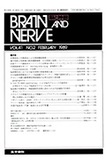Japanese
English
- 有料閲覧
- Abstract 文献概要
- 1ページ目 Look Inside
抄録 ラットにおける胎生期脳血管の経時的発達過程を光顕および電顕下に観察した。その結果,神経管の形成から大脳における神経細胞産生終了までの期間に,脳血管は形態的に三つの時期を経て発達すると考えられた。第1期:胎生11日から12日までの神経管形成期で,脳血管は神経組織周囲にのみ存在する。血管内皮は問葉系細胞から分化したばかりの血管芽細胞からなり,多数の窓あき構造(pore)を有していた。第2期:胎生13日から16日頃までで,脳表血管が実質内へ侵入し,実質内の血管形成時期である。周囲に少量の基底膜様物質を有する内皮細胞が,管腔側や基底膜側で複雑な入り組みや,大小のvacuoleを胞体内に形成しながら厚さを増し,これらに対応するように窓あき構造が減少していった。周皮細胞が形成され始めていた。第3期:胎生17日から21日頃までで,実質内外に認められる内皮細胞の厚い胞体が,均等に菲薄化を示す時期である。基底膜様物質は主に内皮細胞と周皮細胞の外側にあり,ほぼ全周を被覆していた。内皮細胞の窓あき構造はすでに消失し,グリア細胞の血管足が未形成であることを除くと,脳血管の基本構造が形成されていた。これら大脳の初期発生における脳血管の一連の形態変化は,神経細胞の産生およびその移動という特有な形態形成過程と密接に関連するものと思われた。
Developmental changes of cerebral blood vessels in the rat fetal brain from the embryonic day 11 (E 11) to E 21 were chronologically observed with light and electron microscopes. Based on the fine structures the development of the blood vessels was divided into three successive stages : Stage I (from E 11 to E 21). The neural groove fused at the dorsal portion and transferred to the neural tube. Endothelial cells located only around the neural tissue, and showed a primitive nature in their cellular structures, such as immature nucleus and intracytoplasmic organelles. There were many pores at the thin portion of the cytoplasmic processes. Stage II (from E 13 to E 16). Matrix cells in the neural tube began to produce neuro-blasts. These neuroblasts migrated from the ma-trix layer and were recognized as the migrating zone just outside the matrix layer. The formation of the migrating zone started at the ventrolateral portion and successively spread to the lateral neopallium and then to the medial one of the cere-brum. Perineural vessels invaded into the neural tissue at the ventrolateral portion and were distri-buted in the migrating zone and the matrix layer. It was the first appearance of the intraneural blood vessels, and the next invading seemed to follow the area which formed the migrating zone. The endo-thelial cells at this stage became to increase their cytoplasmic thickness and simultaneously to pro-trude many cell processes to the luminal and ablu-minal sides. Numerous large vesicles in the cyto-plasm were also observed. Being associated with the vesicle formation the pores in the cytoplasm were rapidly decreased. Pericytes were recog-nized around the endothelial cells. Basement mem-brane-like materials were discontinuously accumu-lated around endothelial and pericytic surfaces. However, these materials were not observed in the intercellular space between both cells. Stage III(from E 17 to E 21). In the cerebral neopallium, three neuronal cell layers, cortical plate, migrating zone and matrix layer were noticed. Thickened endothelial cells distributed in the subarachnoid space and the neural parenchyma, became thinner evenly in their walls. Basement membrane-like materials partly covering the surfaces of pericytes and endothelial cells spread to envelop most area of these cells, while these materials formed, in part, a lamina densa of the basal lamina. Pores in the endothelial cells disappeared completely.
Thus, the essential structures as a cerebral endo-thelial cell and its associates were accomplished up to E 21, except for still lacking the vascular endfeet of glial cells, which are known to complete at three postnatal weeks. Based on these results, it was suggested that cerebral endothelial cells developed with close relation to the dynamic neural cyto-genesis, such as neuroblast formation and migration to their destinations during the fetal period of the rat brain.

Copyright © 1989, Igaku-Shoin Ltd. All rights reserved.


